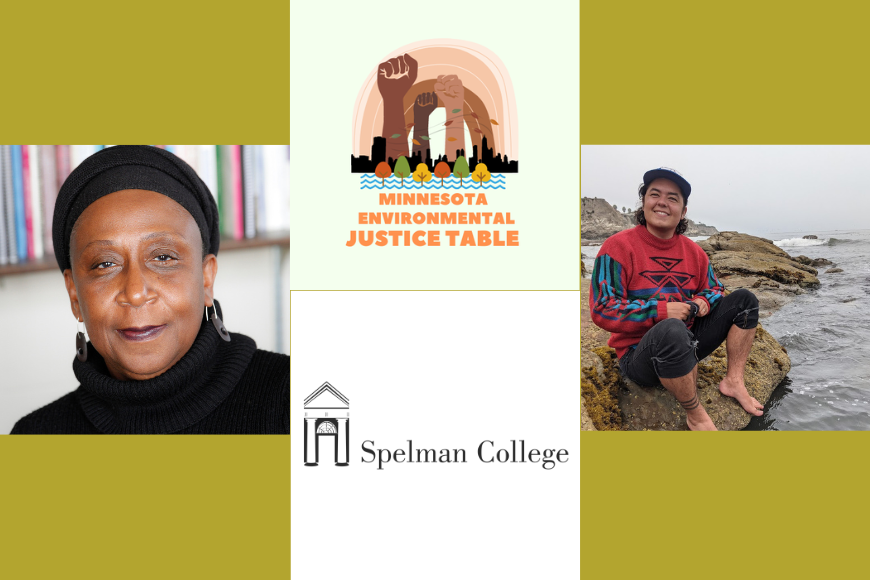Environmental Justice Worldmaking
Environmental Justice is a longstanding fight waged by African American and Indigenous activists against the racialized dumping of the toxic byproducts of capitalist-industrialist society into their communities. It is a project which aims to identify and counter the many instances where systemic racism and environmental destruction intersect. This has the intended outcomes of improving the health and quality of life of disenfranchised people, reducing the effects of environmental degradation and climate change, and strengthening democratic and social ties within our society, since undertaking this project requires an intense level of cooperation. Environmental Justice is not new and activists have been advocating for it for centuries, ever since those existing on the margins of American political and social power have been forced to live in the landfill and toxic air and polluted water infested geographic margins of our country. This struggle was brought into mainstream consciousness in 1987, when the United Church of Christ Commission for Racial Justice released its groundbreaking study, “Toxic Waste and Race in the United States,” showing that race was the primary determinant of where toxic waste was dumped and illustrating the widespread health effects this caused in the form of “cancer alleys.”
Environmental Justice Worldmaking: The Project
Dr. Rose Brewer, Professor in the Department of African American & African Studies and RIDGS-affiliated faculty, has received a Humanities Without Walls (HWW) Grand Research Challenge Project grant to work closely with those community activists and build new visions of what a society which takes seriously the project of Environmental Justice can look like. Brewer is working with University of Minnesota’s Interdisciplinary Center for the Study of Global Change (ICGC) as the institutional home for the grant as the ICGC has long been a hub for Environmental Justice expertise.
Dr. Brewer’s grant is entitled “Environmental Justice Worldmaking (EJW): Redistribution and Reciprocity for a Just Transition,” and is being done in collaboration with the Environmental Justice Health Alliance and Spelman College in Atlanta, and the Minnesota Environmental Justice Table and the University of Minnesota in Minneapolis. It aims to bring those communities most affected by environmental racism in those cities into conversations about local solutions. The initiative is an exercise in collective leadership; the team meets regularly and makes decisions together. Isaac Esposto, a PhD student in Gender, Women, and Sexuality Studies, is the project’s Research Assistant and is working on bringing these groups together and turning their ideas into reality. Land Grant and private universities, such as the University of Minnesota, have largely been able to escape the effects of environmental destruction by owning large swaths of land in desirable areas and possessing the political power to keep themselves insulated from the harmful environmental consequences of population growth and dirty energy production. Dr. Brewer critiques the academy’s current stance on Environmental Justice, saying that it has been slow to recognize the movement in its curriculum and action, despite its rhetoric of redistribution and greenwashing, and even slower to acknowledge the work done by community activists.
Goals
The EJW Project has numerous short term and long term goals. Most immediately, Dr. Brewer, in collaboration with Dr. Tania Mitchell of the College of Education and Human Development’s OLPD department, will be offering a course on Environmental Justice in the Spring of 2023 through the ICGC. The course will incorporate the research being done in the EJW and will include a summer component in which students work closely with community activists to conduct research and study sessions to generate solutions to the most pressing Environmental Justice concerns facing Minneapolis and Atlanta. The EJW Initiative is also looking to make available their research and strategies on a website to allow other community members to get involved. Brewer also hasn’t ruled out getting involved in the political space, believing that the EJW can convert their research and work into concrete policy proposals for local and state governments to take more action in building a more environmentally just community.
Spelman College is a vibrant space of Environmental Justice work, both in its academics and its culture. Brewer points out that the fact that Spelman is an undergraduate institution creates a different research dynamic than the one which exists at the U of M, and that ideally, her U of M graduate students and Spelman undergrads can be brought together in one virtual course for a truly fresh exchange of methodologies, contexts, and approaches to EJW work.
Brewer is also planning on holding gatherings at various points throughout the initiative to share out the work which has been done. She wants to ensure that these gatherings will often take place in Atlanta, acknowledging that HBCUs are often the partners who are made to travel in any inter-institution project (and, of course, it would be especially inconsiderate to make them travel to Minnesota for winter conferences).
Philosophy and Practice
Brewer has been intentional about designing this project in a radically collaborative and interdisciplinary way. This will not be the kind of community work which involves academics marching into the community and expecting them to be grateful for the blessings of knowledge they will bestow upon them. Rather, EJW is an exercise in non-hierarchical shared learning. As Brewer says, “The community has all the answers; they just need unconditional support.” Esposto also called attention to the fact that a primary goal of this initiative is to create a self-sustaining collective into which all members of the community can contribute as they have the capacity over time. They note that academic collaborations with community members are often structured around the arbitrary time units of semesters, which do not reflect the schedules of the partners’ work.
Esposto also highlights that a particularly tricky, but worthwhile goal of the EJW is to create a collaborative project between colleges and community members in which the work is not automatically centered around the colleges, both in terms of physical location and priorities. Brewer sees this as a particularly potential-laden aspect of the work, saying:
[There is] the desire to shift the university dynamic in a way that changes the terrain around what is known and what should be known, who is lifted up and who isn’t. That’s a dicey process, but it’s one of the visions that, somehow, in however small a space, we can be in a position to shift those logics, or illogics, in the context of this institution… The emphasis is on redistribution and shifting the dynamic from inside to outside.
They are grateful for the HWW grant’s support of redistribution. Esposto says, “In the desert, cactuses can only grow under the nurse trees. This grant is like the nurse tree that allows it to be possible for these things to grow.” The grant allows their community partners to continue and expand the work which they have been doing, without compensation, for years.
The Environmental Justice Table
The Environmental Justice Table at present is researching the Hennepin Energy Recovery Center (The HERC), a trash incinerator located on the North Side of Minneapolis to determine the societal and health effects it has caused in the surrounding low-income, Black and Brown neighborhoods. They are looking to ensure that Minnesota’s future energy generation plans do not include the HERC. An Environmental Justice Table activist, Nazir Khan, gave more in-depth detail on this project in an interview. Environmental injustices like these are especially pernicious and difficult to remedy because of how deeply ingrained they are in the American landscape. For countless reasons, an entire community, or even individuals within those communities, affected by toxic pollution cannot simply get up and leave. And the plant itself cannot be simply shut down because of how reliant our power and waste management systems have become on them. This is why the concept of a “just transition” is emphasized in the project, since the solution to environmental racism requires a far more expansive transformation than merely changing the attitudes of racial expendability which created the problem in the first place. While this is a project of massive scale and vision, Esposto emphasizes the fact that this is a project in which everyone can participate at different levels and we should not be intimidated by the amount of work left to do, saying:
There’s so often these really helpful rhetorics in abolition and environmental justice and transformative justice about ‘after the revolution,’ and I think this grant is like, ‘but what are the things we set up now? What does it look like when we’re already in the revolution, we’re already in crisis, and what is the day-to-day that we’re doing? What can we do in this time period right now to stop that feeling of immobilization that comes when you’re dealing with something like environmental justice and racism?
Brewer and Esposto have learned to expect the unexpected when doing this work, as new routes for research and collaboration open up every day. They are currently seeking out additional graduate students who are interested in the Spring 2023 course and the community-based work. Interested students can contact Brewer at brewe001@umn.edu.


